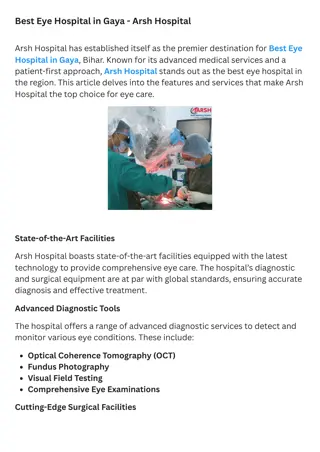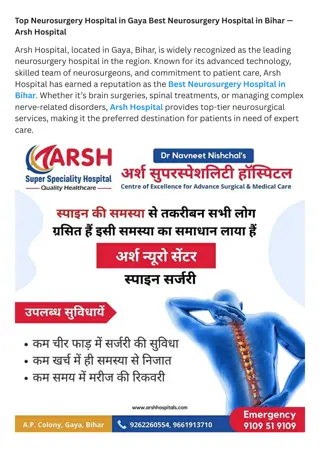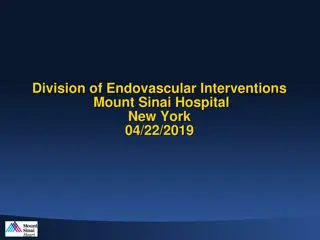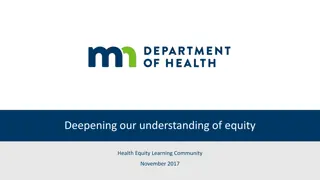Building Equity at Mount Sinai Hospital
Through integration practices, Mount Sinai Hospital aims to eradicate segregated care based on insurance statuses, ultimately combating de facto racial segregation. Learn about their initiatives, challenges, and successes in promoting equitable healthcare access and quality.
Download Presentation

Please find below an Image/Link to download the presentation.
The content on the website is provided AS IS for your information and personal use only. It may not be sold, licensed, or shared on other websites without obtaining consent from the author.If you encounter any issues during the download, it is possible that the publisher has removed the file from their server.
You are allowed to download the files provided on this website for personal or commercial use, subject to the condition that they are used lawfully. All files are the property of their respective owners.
The content on the website is provided AS IS for your information and personal use only. It may not be sold, licensed, or shared on other websites without obtaining consent from the author.
E N D
Presentation Transcript
Building Equity Through Integration: Three Integrated Practices at Mount Sinai Hospital? Katherine Garvey and Michael Miller Human Rights and Social Justice Program Symposium Icahn School of Medicine at Mount Sinai April 26, 2018
Outline - - - Current status of segregated care at Mount Sinai Project: Interviewing three integrated departments at Mount Sinai Takeaways and next steps
Definitions: Segregated Care Patients with different insurance statuses (public vs. private) receive different access to and/or quality of care. Segregation by insurance status is de facto segregation by race.
At Mount Sinai Hospital Faculty Practice Associates (FPA) Center for Advanced Medicine (CAM)
Definitions: Integrated Care All patients are seen by the same physicians, in the same location, at the same time.
Barriers to Integration - - - - Financial Space Racism Transition
Goals Understand the structure of integrated departments and how they have navigated the aforementioned barriers to integration.
Approach - Identify integrated departments within Mount Sinai - Susan and Leonard Feinstein Inflammatory Bowel Disease Clinical Center - Ruttenberg Treatment Center/Dubin Breast Center (Oncology) - Institute for Liver Diseases Conduct semi-structured interviews with these departments -
Interview Questions Transition - Clinic Structure - How is the clinic structured? When are commercially insured patients seen? When are those insured with Medicaid seen? - Who staffs this clinic? - If applicable, why are Medicaid patients seen on different days with different providers? Post-Integration Experience - How, if at all, did the transition impact the care or experience of your patients? Of your providers? - Are there any challenges with how the clinic is run currently? When did this practice transition to an integrated model? What prompted this transition? How was this transition? How long did it take to complete? - -
Transitions Timeline Dubin Breast Center IBD Clinical Center 2010 2016 2011 2017 Ruttenberg Treatment Center Institute for Liver Diseases
Common Themes - - Decision to integrate was financially motivated Transitions were difficult, but no perceived drop in productivity
340B Drug Discount Program Source: https://chartpack.phrma.org/programs-chartpack/medicines-in-340b/how-340b-discounts-work
Same Physicians? Physicians - IBD and Liver: Fellows only see patients with Medicaid Inflammatory Bowel Disease Oncology Liver
Same Location? Location - Patients in all three departments are seen in the same physical space Inflammatory Bowel Disease Oncology Liver
Same Time? - IBD: Patients insured by Medicaid are seen on Fridays by Fellows and Attendings; those with commercial insurance are seen Monday-Thursday by Attendings only Liver: ? Time Inflammatory Bowel Disease Oncology Liver -
Summary Physicians Location Time Inflammatory Bowel Disease Oncology Liver
Common Themes - No evidence that providers or patients were dissatisfied with new clinic structure Perception that integrated practices were generating more revenue Perception that wait-times have improved for publicly insured patients - -
Takeaways - Transitions were difficult but doable without noticeable dips in productivity or revenue - Due to 340B, integration has been profitable All departments noted no patient or physician dissatisfaction with integration - General consensus that this was a positive for all involved Even integrated departments do not meet our definition of integration - -
Next Steps - Collaborate with Health Equity Task Force to define integration and link 340B incentive to meeting the requirements of this definition - Next practice to integrate: Rheumatology (Fall 2018) More rigorous data collection pre- and post-integration -
Thank you! Special Thanks To - Connor Fox & Brielle Cardieri (Last Year s Dyad) - Jorge Rodriguez - Dr. Cam Hernandez - Sonia Pagan-Pastor, Practice Manager for IBD - Melissa Bellino, VP for Oncology - Alyson Harty, Clinical Nurse Manager for Liver - Orlando Morel, Practice Manager for Liver























